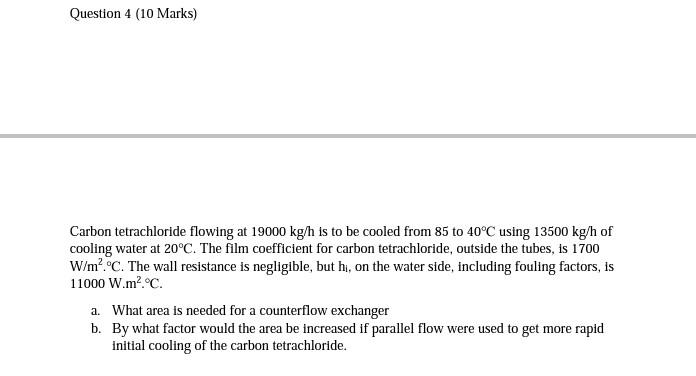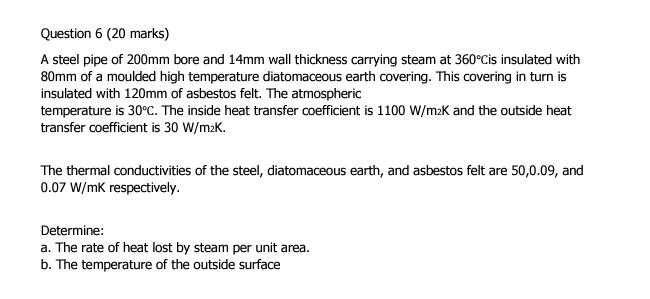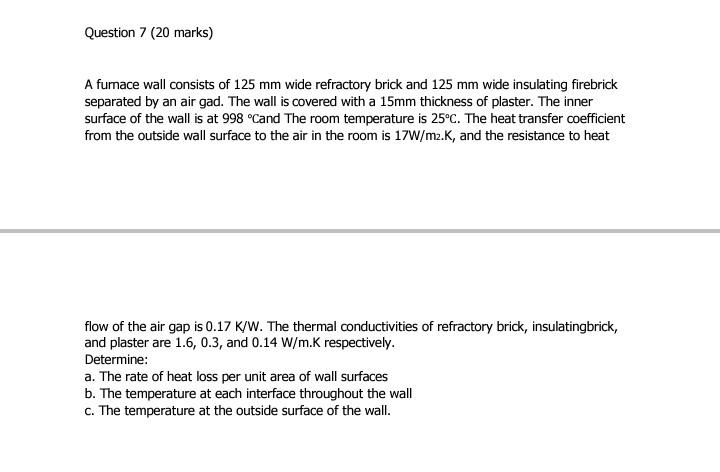Answered step by step
Verified Expert Solution
Question
1 Approved Answer
Question 1 (10 Marks) A furnace wall consists of 200 mm of refractory fireclay brick, 100 mm of kaolin brick, and 6 mm of steel







Question 1 (10 Marks) A furnace wall consists of 200 mm of refractory fireclay brick, 100 mm of kaolin brick, and 6 mm of steel plate. The fire side of the refractory is at 1150 C, and the outside temperature of the steel is at 30C. An accurate heat balance over the furnace shows the heat loss from the wall to be 300 W/m. It is known that there may be thin layers of air between the layers of brick and steel. a. To how many millimeters of kaolin are these air layers equivalent? The thermal conductivities of fireclay brick, kaolin brick, and steel can be taken as 1.7 W/m.C, 0.11 W/m.C, and 45 W/m.C respectively Question 2 (10 Marks) A thick-walled tube of stainless steel having a thermal conductivity of 21.63 W/m.K with dimensions of 0.0254m ID and 0.0508 m OD is covered with a 0.2054 m thick layer of insulation (k = 0.2423 W/m.K). The inside wall temperature of the pipe is 811 K and the outside surface temperature of the insulation is 310.8 K. For a 0.305 m length of pipe, calculate the heat loss and also the temperature at the interface between the metal and the insulation. Question 3 (10 Marks) A 0.488m thick furnace wall is constructed of a material having a thermal conductivity of 2.60W/mK. The outside of the wall will be insulated with a material having an average k of 0.692W/mK, such that the heat loss from the furnace will be s 1830W/m2. The inner surface temperature is 1300K and the outer temperature is 298K. a. Determine: The thickness of the insulation required Question 4 (10 Marks) Carbon tetrachloride flowing at 19000 kg/h is to be cooled from 85 to 40C using 13500 kg/h of cooling water at 20C. The film coefficient for carbon tetrachloride, outside the tubes, is 1700 W/m. C. The wall resistance is negligible, but hi, on the water side, including fouling factors, is 11000 W.m. C. a. What area is needed for a counterflow exchanger b. By what factor would the area be increased if parallel flow were used to get more rapid initial cooling of the carbon tetrachloride. Question 5 (10 marks) A 100 mm diameter pipe of circular cross-section with walls 6mm thick is covered with two concentric layers of lagging. The inner layer of lagging has a thickness of 50mm and a thermal conductivity of 0.04W/Mk. The temperature inside the pipe is 600K and the temperature of the outside surface is 380K. The thermal conductivity of the wall is 45W/Mk. Determine: a. The rate of heat loss per metre length of the pipe. Question 6 (20 marks) A steel pipe of 200mm bore and 14mm wall thickness carrying steam at 360is insulated with 80mm of a moulded high temperature diatomaceous earth covering. This covering in turn is insulated with 120mm of asbestos felt. The atmospheric temperature is 30C. The inside heat transfer coefficient is 1100 W/m2K and the outside heat transfer coefficient is 30 W/m2K. The thermal conductivities of the steel, diatomaceous earth, and asbestos felt are 50,0.09, and 0.07 W/mK respectively. Determine: a. The rate of heat lost by steam per unit area. b. The temperature of the outside surface Question 7 (20 marks) A fumace wall consists of 125 mm wide refractory brick and 125 mm wide insulating firebrick separated by an air gad. The wall is covered with a 15mm thickness of plaster. The inner surface of the wall is at 998 "Cand The room temperature is 25C. The heat transfer coefficient from the outside wall surface to the air in the room is 17W/m2.K, and the resistance to heat flow of the air gap is 0.17 K/W. The thermal conductivities of refractory brick, insulatingbrick, and plaster are 1.6, 0.3, and 0.14 W/m.K respectively. Determine: a. The rate of heat loss per unit area of wall surfaces b. The temperature at each interface throughout the wall C. The temperature at the outside surface of the wall
Step by Step Solution
There are 3 Steps involved in it
Step: 1

Get Instant Access to Expert-Tailored Solutions
See step-by-step solutions with expert insights and AI powered tools for academic success
Step: 2

Step: 3

Ace Your Homework with AI
Get the answers you need in no time with our AI-driven, step-by-step assistance
Get Started


